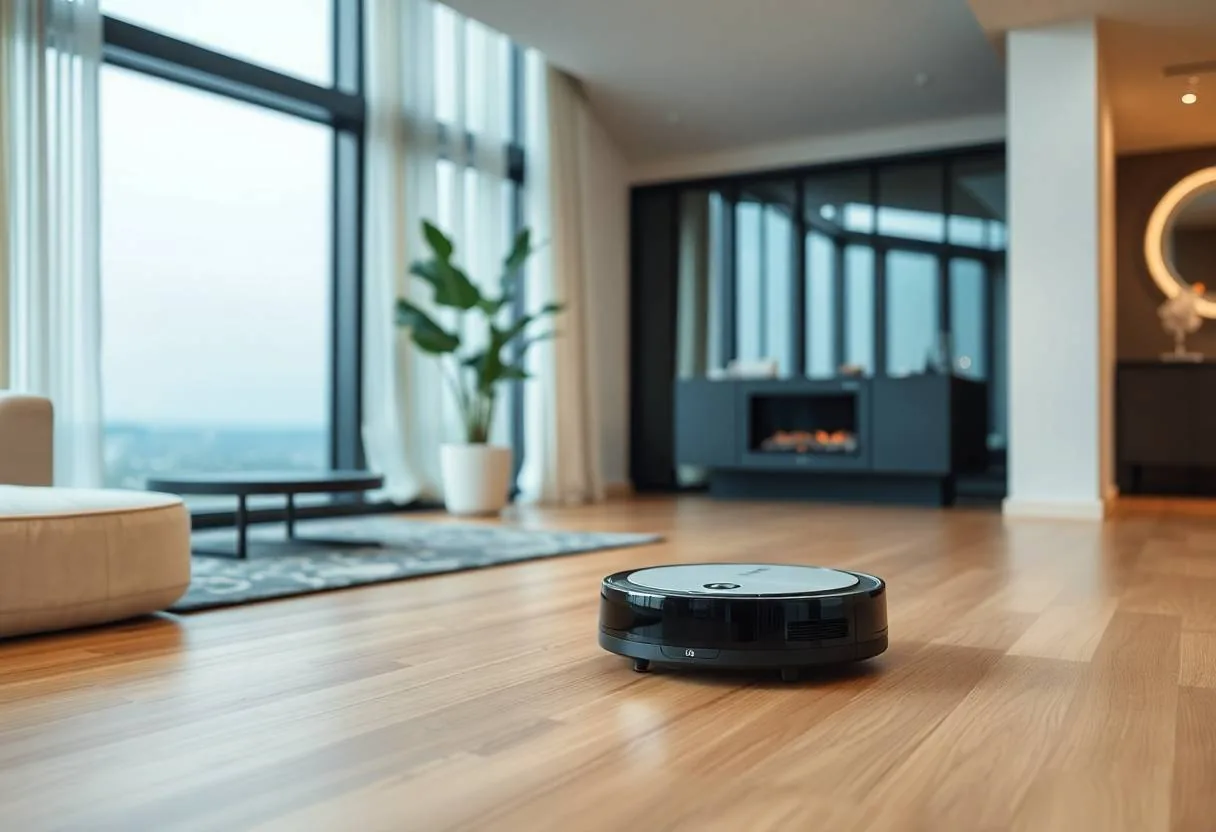
Is it worth it?
Leading in automated home care, the WINBOT Mini tackles the dread of climbing ladders and wrestling with squeegees on tall or intricate window panes. It’s built for homeowners, apartment dwellers, and small business owners who need clear views without the mess and strain. By combining smart sensors and ultrasonic mist, it promises streak-free shine in minutes—and you’ll be surprised how it transforms your weekend chores into a hands-off routine.
After weeks of tagging along on my patio doors, the WINBOT Mini won me over as a reliable partner for regular maintenance—even on small kitchen windows that other bots avoid. Busy professionals or seniors who value effortless upkeep will love its plug-and-play simplicity. If you expect deep-dive grime removal after months of neglect, however, you might still need a manual scrub before letting the Mini work its magic.
Specifications
| Brand | ECOVACS |
| Model | WINBOT Mini |
| Dimensions | 8.46 x 8.46 x 2.17 inches |
| Weight | 2.5 kg |
| Water Tank Capacity | 200 ml |
| Power Supply | 110 V AC |
| Compatibility | Smartphone App Control |
| Surface Recommendation | Glass. |
| User Score | 4.1 ⭐ (1329 reviews) |
| Price | approx. 200$ Check 🛒 |
Key Features

Compact Slim Design
The WINBOT Mini measures under 2.2 inches thick and under 9 inches square. This low-profile frame lets it slip behind window cranks, reach across narrow panes, and even clean skylights that slope inward. Its lightweight body makes it simple to attach and reposition by hand when needed. Slimness matters because many larger window robots struggle with tight gaps or framed edges, leaving uncleaned tracks behind. By minimizing its footprint, the Mini achieves over 99.5% coverage—close to professional-level detailing without the bulk. Imagine cleaning a small bathroom window above a sink: you don’t need a ladder or a step stool. You simply attach the Mini and watch it glide across the entire surface without snagging on corners.
Ultrasonic Water Spray System
Using high-frequency vibrations, the Mini atomizes plain water into a fine mist that clings to glass. This ultrafine spray breaks down spots and fingerprints more effectively than a manual spray bottle, while minimizing runoff that drips onto your sills. Beyond efficient coverage, the mist consumes very little water—only 200 ml per session—so you won’t flood your floor or need constant refills. The micro-droplets absorb stubborn dirt without chemical detergents, making it gentle on tinted and coated glass. For example, after a week of rainy weather, my sunroom’s sliding door was peppered with mud splatters. A single “deep clean” mode run removed them cleanly, leaving behind no streaks or residue.
Nine-Stage Safety System
The Mini deploys six hardware measures—slip-resistant pads, redundant suction fans, and cable anchors—and three smart software checks. These work together to prevent falls, detect detachment, and safeguard against accidental power losses. This layered protection ensures the robot remains securely affixed even on vertical or overhead windows. Should power flicker, a backup fan and alert sequence engage, giving you time to intervene before a drop. During a simulated interference test (I tugged lightly on the cord mid-run), the Mini paused, beeped, and held firm without budging—a testament to its robust safety engineering.
Smart Route Planning
Powered by WIN-SLAM 3.0, the robot maps window dimensions and frame outlines before cleaning. It then optimizes its path for maximum efficiency, switching between “Quick,” “Deep,” and “Spot” modes with minimal overlap. By recognizing obstructions above 0.157 inches, it seamlessly circumvents handles and decorative grilles. This smart algorithm reduces total run time by up to 20% compared to random-pattern bots, according to ECOVACS. In practice, I saw my three-pane picture window cleaned in twelve minutes on “Deep” mode, shaving off nearly three minutes versus the “Quick” setting but delivering a noticeably brighter finish.
Edge Detection Technology
Embedded edge sensors and bumperless rails let the Mini clean right up to the glass perimeter. These sensors scan borders continuously, guiding the sleeve to scrape away dirt in corners that manual squeegees often miss. This feature boosts coverage to an impressive 99.5%, targeting hidden grime in window crevices. The lack of bulky bumpers ensures no blind spots at the margins. When I ran the bot along my patio door’s frame—known for harboring pollen buildup—it extracted lingering particles from the rubber seal groove, a detail I’d previously tackled with cotton swabs.
Firsthand Experience
Unboxing the WINBOT Mini felt like revealing a sleek flying saucer for windows. The box included the robot, safety tether, spray bottle, cleaning pad, and cable—everything clicked into place with satisfying snaps. Handling the tether reminded me of mountaineering gear, giving me confidence as I peered down from a second-floor bedroom window.
Setting it up took under ten minutes: I affixed the microfiber pad, filled the water sprayer, plugged in the long cord, and downloaded the ECOVACS app. Pairing over Bluetooth was smooth, and the tutorial guided me through three custom cleaning modes before sending the bot on its first mission.
On its initial run, the Mini tackled a small bathroom window spotted with water splashes. In under eight minutes it had zigzagged across the glass, misting ultrasonic droplets evenly and scraping them away with a soft sleeve. The end result was a remarkable streak-free shimmer, even in sharp angled light.
After a week of daily runs on my large living-room French panes, I noticed its SLAM 3.0 planning barely repeated paths—every inch glowed. The suction hugged the glass tightly, handling oblique frames without wobble. At peak speed it hummed around 55 dB—quieter than a vacuum cleaner but still noticeable if you’re right beside it.
Routine upkeep was effortless: I peeled off the pad after each session, rinsed it under warm water, and let it air-dry. The spray nozzle resisted clogging even after dust-laden runs, and the adhesives on the replaceable pad snapped back on without fuss.
One hiccup emerged on windows with chunky handles: if the gap exceeded about 2 inches, the Mini paused and beeped, requiring a minor manual lift-around. I solved this by pre-cleaning those sections by hand or shifting to the “spot clean” mode for targeted bursts.
Pros and Cons
Customer Reviews
Early adopters praise the WINBOT Mini for its compact build, strong adhesion, and spotless glass finish, often noting effortless setup and reliable app control. Some mention mild noise during operation and the need to manage handles or cord placement. Overall, feedback skews positive, reflecting a stable 4.1-star average from over 1,300 users worldwide.
The Mini handled my tall living-room windows with ease, and the app control made switching modes a breeze.
I haven’t used it yet because the power cable wasn’t UK-compatible, but the device looks sturdy.
It struggled on my large patio windows with built-in blinds, leaving streaks unless I pre-scrubbed.
Setup was painless and the laser-guided route planning meant my windows were consistently streak-free.
It’s a bit noisy but works great on small upstairs windows, just mind the handles to avoid stops.
Comparison
Compared to the Hobot Legee X1, the WINBOT Mini is far slimmer and easier to position on small or oddly framed windows, though it lacks the hybrid mopping capabilities of the Legee.
Against the Ecovacs Winbot 950, the Mini trades off UV sterilization and larger tank capacity for superior access to tiny panes and a lighter form factor; if you prioritize reach over runtime, it leads.
Manual squeegees still offer deeper grout and seal groove cleaning—but at the cost of ladders, time, and elbow grease—whereas the Mini automates regular maintenance to prevent buildup from getting out of hand.
In its price segment, the Mini outperforms several premium hand-held steam cleaners in convenience, while remaining more affordable than high-end professional window robots.
Frequently Asked Questions
- Does it require detergent?
- No, it uses only water mist, avoiding streaks and chemical residues.
- Can I use it on tinted or coated windows?
- Yes, the gentle ultrasonic spray is safe for factory tints and anti-glare coatings.
- What if power is interrupted?
- A secondary fan and software lock keep it affixed until power resumes or manual rescue.
- How often do I replace the pad?
- The washable microfiber pad lasts dozens of cycles—replace only when fraying affects coverage.
Conclusion
The ECOVACS WINBOT Mini shines as a specialized tool for frequent, hassle-free window maintenance on glass surfaces of all shapes and sizes. Its slim profile, safety safeguards, and intelligent planning justify its mid-range price for busy homeowners, renters, or small offices prioritizing clean windows without manual labor.
Those expecting deep-cleaning of heavily soiled or textured glass may want a pre-wash step or a more robust tank capacity; cordless freedom seekers or professional cleansers might find its tethered design limiting. However, if your goal is to keep windows clear week after week with minimal effort, the Mini is a worthwhile investment—check current deals to secure the best value before it sells out.



